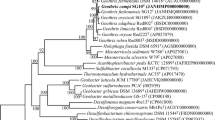Abstract
Pseudomonas cepacia MBA4 able to utilize monobromoacetic acid as a sole source of carbon and energy was isolated from soil by enrichment culture. In batch culture the ability to utilize the substrate was conferred by a single halidohydrolase-type dehalogenase which demonstrated a high activity towards the enrichment substrate. The purified enzyme, designated as dehalogenase IVa by activity-stain polyacrylamide gel electrophoresis, had a relative molecular weight of 45,000 and was comprised of two electrophoretically identical subunits with relative molecular weights of 23,000. Dehalogenase IVa demonstrated isomer specificity, being active towards the L-isomer of 2-monochloropropionic acid only. The significance of activity-stain polyacrylamide gel electrophoresis in characterizing dehalogenases and their ubiquitous distribution among bacterial genera are discussed.
Similar content being viewed by others
Abbreviations
- MCA:
-
Monochloroacetic acid
- DCA:
-
dichloroacetic acid
- MBA:
-
monobromoacetic acid
- 2MPCA:
-
2-monochloropropionic acid
- 2MBPA:
-
2-monobromopropionic acid
References
Allison L, Skinner AJ, Cooper RA (1983) The dehalogenases of a 2,2′-dichloropropionate degrading bacterium. J Gen Microbiol 129:1283–1293
Bergmann JG, Sanik J (1957) Determination of trace amounts of chlorine in naphtha. Anal Chem 29:241–243
Berry EKM, Allison N, Skinner AJ (1979) Degradation of the selective herbicide 2,2′-DCPA (Dalapon) by a soil bacterium. J Gen Microbiol 110:39–45
Fu S-CJ, Birnbaum SN, Greenstein JP (1954) Influence of optically active acyl groups on the enzymatic hydrolysis of N-acylated-L-amino acids. J Am Chem Soc 76:6054–6058
Goldman P (1965) The enzymatic cleavage of C-F bond in fluoraacetate. J Biol Chem 240:3434–3438
Goldman P, Milne GWA, Keister DB (1968) Carbon-halogen bond cleavage. III Studies on bacterial halidohydrolases. J Biol Chem 243:428–434
Hall BG, Yokoyama S, Calhoun DH (1983) Role of cryptic genes in microbial evolution. Mol Biol Evol 1:109–124
Hardman DJ, Slater JH (1981a) Dehalogenases in soil bacteria. J Gen Microbiol 123:117–128
Hardman DJ, Slater JH (1981b) The dehalogenase complement of a soil pseudomonad grown in closed and open cultures on haloalkanoic acids. J Gen Microbiol 127:399–405
Jensen HL (1960) Decomposition of chloroacetates by bacteria. Acta Agric Scand 10:83–103
Kawasaki H, Tone N, Tonomura K (1981a) Plasmid determined dehalogenation of haloacetates in Moraxella sp. Agric Biol Chem 45:29–34
Kawasaki H, Tone N, Tonomura K (1981b) Purification and properties of haloacetate halidohydrolase specified by plasmid from Moraxella sp. strain B. Agric Biol Chem 45:35–42
Kawasaki H, Hayashi S, Yahara H, Minami F, Tonomura K (1982) Plasmid pUO2 determining haloacetate dehalogenase and mercury resistance in Pseudomonas sp. J Ferment Technol 60:5–11
Keuning S, Janssen DB, Witholt B (1985) Purification and characterization of hydrolytic haloalkane dehalogenase from Xanthobacter autotrophicus GJ10. J Bacteriol 163:635–639
Klages U, Krauss S, Lingens F (1983) 2-Haloacid dehalogenase from a 4-chlorobenzoate-degrading Pseudomonas sp. CBS3. Z Physiol Chem 364:529–535
Laemmli UK (1970) Cleavage of structural proteins during assembly of the head of bacteriophage T4. Nature (Lond) 227:680–685
Lien BC, Cole ALJ, Walker JRL, Peters JA (1979) Effect of sodium fluoroacetate (“Compound 1080”) on the soil microflora. Soil Biol Biochem 11:13–18
Little M, Williams PA (1971) A bacterial halidohydrolase. Its purification some properties and its modification by specific amino acid reagents. Eur J Biochem 21:99–109
Motosugi K, Esaki N, Soda K (1982a) Bacterial assimilation of D-and L-2-chloropropionates and occurrence of a new dehalogenase. Acta Microbiol 131:179–183
Motosugi K, Esaki N, Soda K (1982b) Purification and properties of a new enzyme D,L 2-haloacid dehalogenase from a Pseudomonas sp. J Bacteriol 150:522–527
Sculley MJ, Treacy GB, Jeffrey PD (1984) A new theoretical approach to the investigation of the symmetry of protein oligomers with bifunctional reagents. Biophys Chem 19:39–47
Senior E, Bull AT, Slater JH (1976) Enzyme evolution in a microbial community growing on the herbicide Dalapon. Nature (Lond) 263:476–479
Slater JH, Lovatt D, Weightman AJ, Senior E, Bull AT (1979) The growth of Pseudomonas putida on chlorinated aliphatic acids and its dehalogenase activity. J Gen Microbiol 114:125–136
Slater JH, Weightman AJ, Hall BG (1985) Dehalogenase genes of Pseudomonas putida PP3 on chromosomally located transposable elements. Mol Biol Evol 2:557–567
Tonomura K, Futai F, Tanabe O, Yamaoka T (1965) Defluorination of monofluoroacetate by bacteria. Part I. Isolation of bacteria and their activity of defluorination. Agric Biol Chem 29:124–128
Weightman AJ, Slater JH (1980) Selection of Pseudomonas putida strains with elevated dehalogenase activities by continuous culture growth on chlorinated alkanoic acids. J Gen Microbiol 121:187–193
Weightman AJ, Weightman AL, Slater JH (1982) Stereospecificity of 2-monochloropropionate dehalogenation by the two dehalogenases of Pseudomonas putida PP3: evidence for two different dehalogenation mechanisms. J Gen Microbiol 128:1755–1762
Author information
Authors and Affiliations
Rights and permissions
About this article
Cite this article
Tsang, J.S.H., Sallis, P.J., Bull, A.T. et al. A monobromoacetate dehalogenase from Pseudomonas cepacia MBA4. Arch. Microbiol. 150, 441–446 (1988). https://doi.org/10.1007/BF00422284
Received:
Accepted:
Issue Date:
DOI: https://doi.org/10.1007/BF00422284




